Ferns of the Adirondacks:
Long Beech Fern (Phegopteris connectilis)
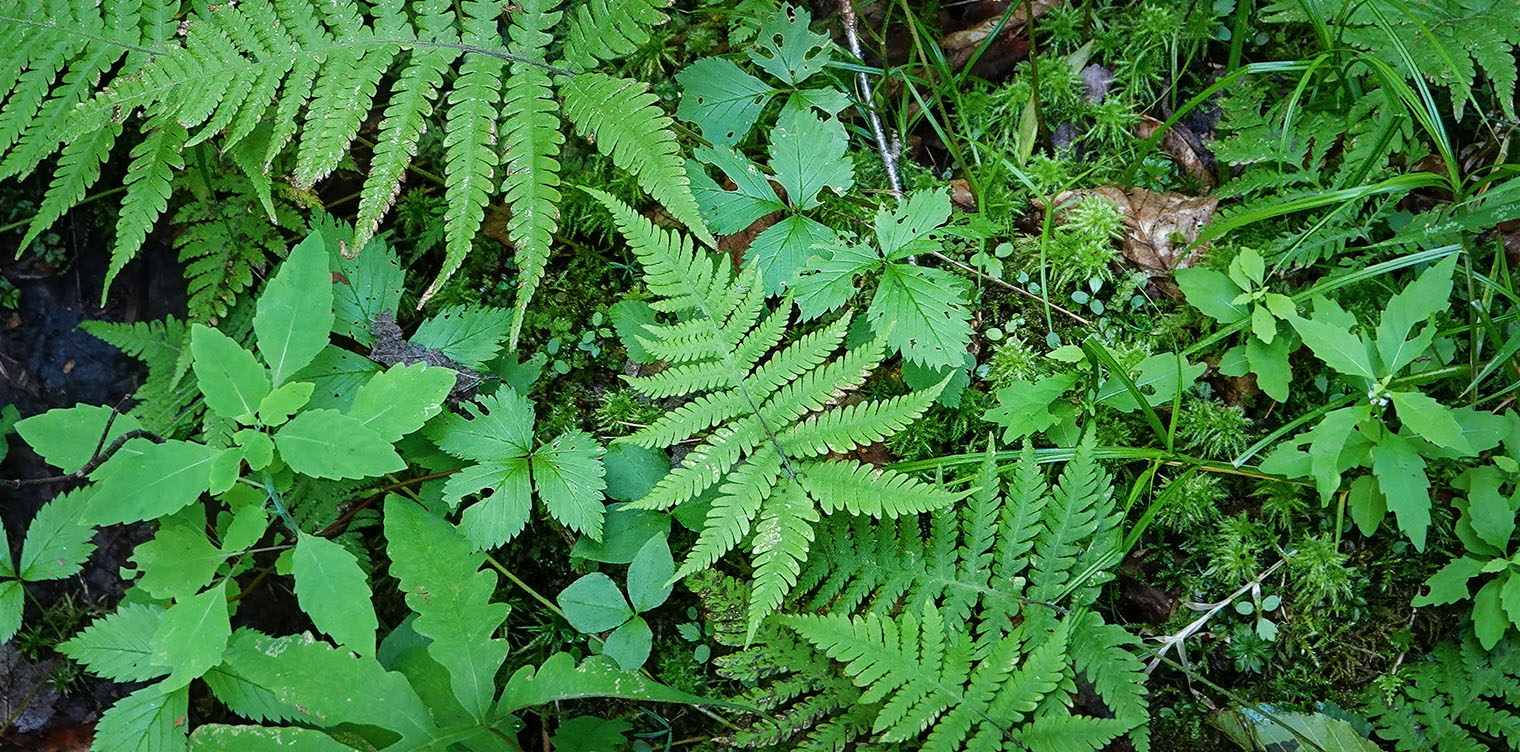
Long Beech Fern (Phegopteris connectilis) is a native, deciduous fern found on shady stream banks and cool, moist woods in the Adirondack Mountains of upstate New York.
The Long Beech Fern is categorized as part of the Thelypteridaceae (Marsh Fern) family, which also includes the New York Fern.
- At one time, Long Beech Ferns were part of the Dryopteris genus. It was then reassigned to the Thelypteris genus.
- The Long Beech Fern was later reassigned once again, this time to the Phegopteris genus. This genus includes two species: Long Beech Fern (Phegopteris connectilis) and Broad Beech Fern (Phegopteris hexagonoptera). Broad Beech Fern is also found within the Adirondack Park, although it is not as widely distributed as the Long Beech Fern.
The genus name Phegopteris is derived from the Greek phegos (beech) and pteris (fern). This is an apparent reference to the fern growing in beech woods in European settings. The species name connectilis is from the Latin connecto, meaning "to fasten together"; this is a reference to the fact that the upper leaflets on the fern are connected.
Other nonscientific names for Phegopteris connectilis include: Narrow Beech Fern, Northern Beech Fern, Northern Beechfern, Long Beechfern, and Beech Fern.
Identification of Long Beech Ferns
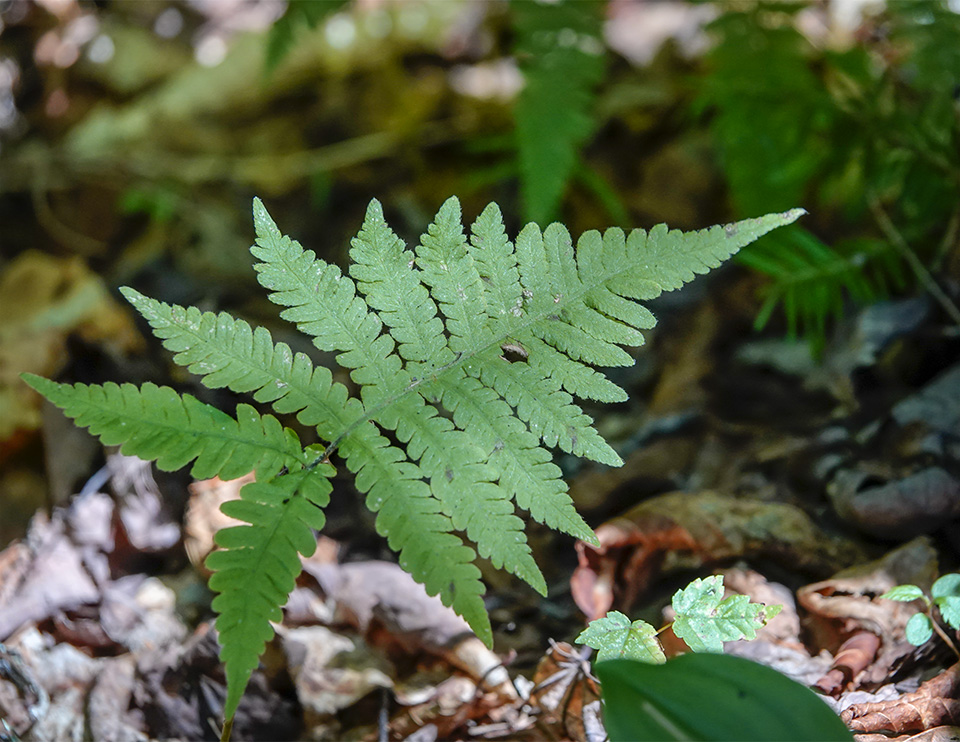
Long Beech Fern is a deciduous perennial plant up to about 14 inches tall. It generally grows in a colony formed by creeping rhizomes Rhizome: The modified subterranean stem of a plant that sends out roots and shoots from its nodes. Rhizomes are also called creeping rootstalks and rootstocks.. These rhizomes (rootstock) are slender, black and scaly, although they become smoother with age.
Rhizome: The modified subterranean stem of a plant that sends out roots and shoots from its nodes. Rhizomes are also called creeping rootstalks and rootstocks.. These rhizomes (rootstock) are slender, black and scaly, although they become smoother with age.
The fiddleheadsFiddlehead: The unfurling young frond of true ferns, which loosely resembles the ornate, curled end of a fiddle. (Synonym=crosier) of Long Beech Fern emerge in early spring. The slender, purple-brown stems are covered in black scales, with some scattered hairs.
The arching fronds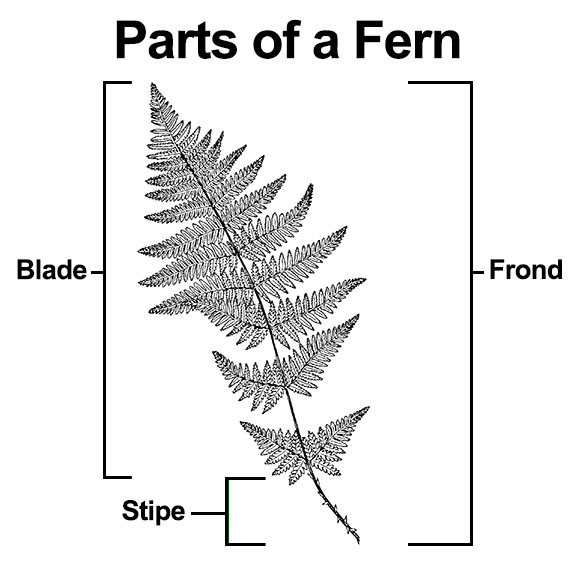 Frond: The whole leaf of a fern. It includes the blade (the expanded leafy part of the frond) and the stipe (the stalk below the blade). (sometimes called leaves) are six to fourteen inches long and up to about ten inches wide. They are not dimorphicFrond dimorphism: Refers to a difference in ferns between the fertile and sterile fronds.; the sterile and fertile fronds are the same size and shape. The rachis
Frond: The whole leaf of a fern. It includes the blade (the expanded leafy part of the frond) and the stipe (the stalk below the blade). (sometimes called leaves) are six to fourteen inches long and up to about ten inches wide. They are not dimorphicFrond dimorphism: Refers to a difference in ferns between the fertile and sterile fronds.; the sterile and fertile fronds are the same size and shape. The rachis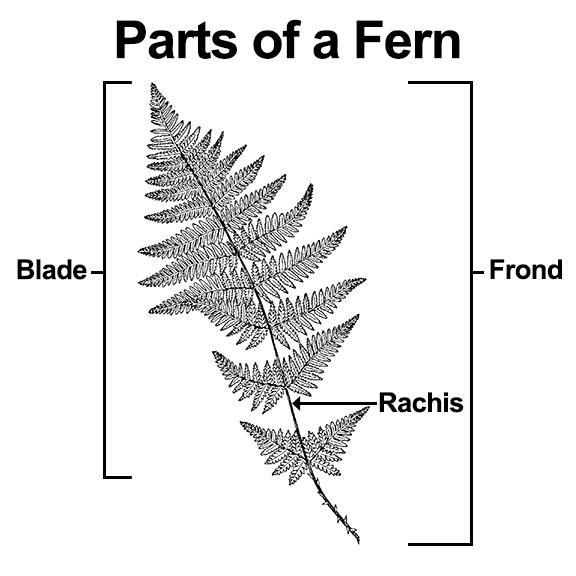 Rachis: The stalk within the blade (the expanded, leafy part of the frond). (the stalk of the blade) is green, densely covered with brown scales, and hairy.
Rachis: The stalk within the blade (the expanded, leafy part of the frond). (the stalk of the blade) is green, densely covered with brown scales, and hairy.
The blade Blade: The expanded, leafy part of the frond. (the leafy part of the frond) is triangular and light green. The blade has 12 or so pairs of leaflets (pinnae
Blade: The expanded, leafy part of the frond. (the leafy part of the frond) is triangular and light green. The blade has 12 or so pairs of leaflets (pinnae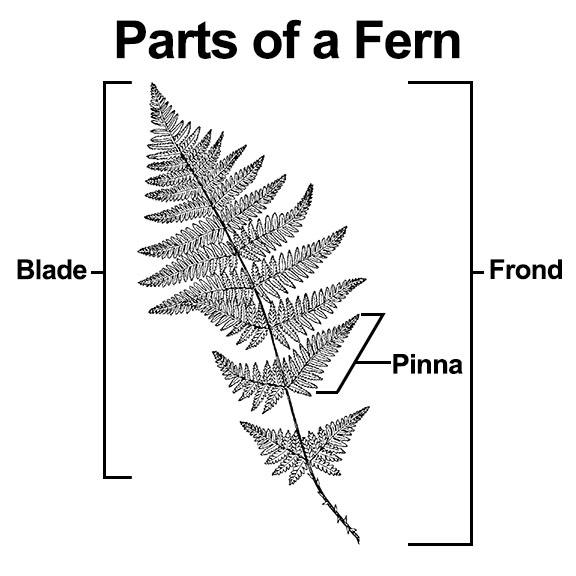 Pinna: A primary division of the blade (plural: pinnae).), which are narrow with long pointed tips. The lowest pair of leaflets is angled downward and distinctly spaced from the next upper pair. Except for this lowest pair of leaflets, all other leaflets are connected by a wing to the rachis
Pinna: A primary division of the blade (plural: pinnae).), which are narrow with long pointed tips. The lowest pair of leaflets is angled downward and distinctly spaced from the next upper pair. Except for this lowest pair of leaflets, all other leaflets are connected by a wing to the rachis Rachis: The stalk within the blade (the expanded, leafy part of the frond).. The leaflets are divided into 10 or twenty pair of oblong pinnules
Rachis: The stalk within the blade (the expanded, leafy part of the frond).. The leaflets are divided into 10 or twenty pair of oblong pinnules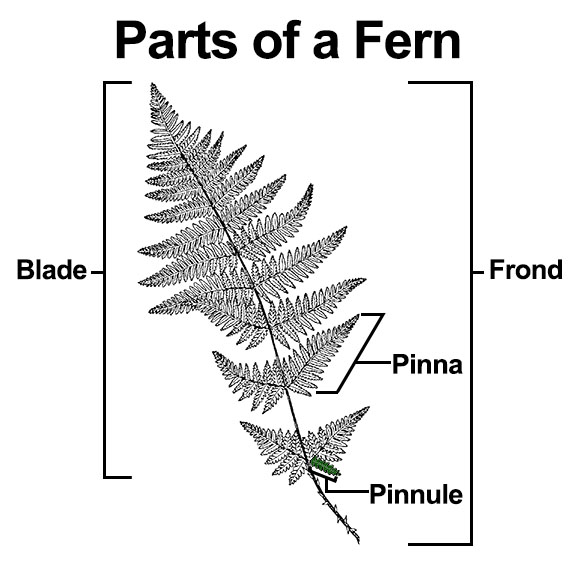 Pinnule: A division of the pinna., which are rounded at the tip. The edges are usually smooth.
Pinnule: A division of the pinna., which are rounded at the tip. The edges are usually smooth.
The soriSorus: A cluster of sporangia, usually borne on the underside or margins of the pinnae or pinnules. (plural = sori) (group of spores) are small and round. They are located on the underside of the leaf, near the margins of the pinnules. The spores ripen to dark brown and are released during the fall, after which the fronds die back for the winter.
Long Beech Ferns may sometimes be confused with Broad Beech Ferns. However, the fronds of Long Beech Ferns are longer than they are wide, while those of Broad Beech Ferns are about as long as they are wide. In addition, the lowest pair of leaflets of the Long Beech Fern are separated from the next highest pair of leaflets and are not winged at the base. All of the leaflets of Broad Beech Fern, by contrast, are winged at the base; and the winged extensions tend to be more wide and angular, producing a hexagonal shape.
Long Beech Fern might also be confused with New York Fern. However, the blade of the New York Fern is widest in the middle and tapers at both ends, with both the upper and lower pairs of leaflets significantly smaller than those in the middle. This contrasts with the shape of Long Beech Ferns, which are triangular with the lowest pair of leaflets pointing down.
Uses of Long Beech Ferns
No edible or medicinal uses of the Long Beech Fern could be found.
Wildlife Value of Long Beech Ferns
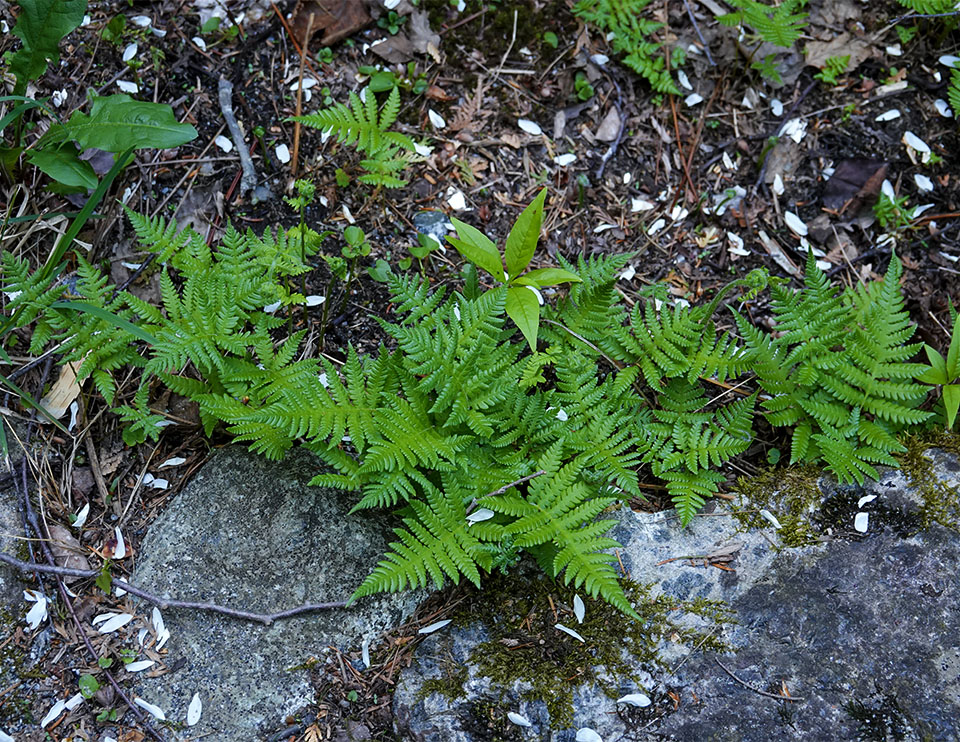
Information on the wildlife value of Long Beech Ferns is limited. In general, ferns are not a major food source for wildlife. The small size of fern spores eliminates them from significance as a menu item for mammals and birds. Several wildlife species (such as Wild Turkey and Spruce Grouse) reportedly consume a few evergreen ferns (such as Christmas Fern) in the winter, during times when other green plants are scarce. However, Long Beech Ferns are deciduous, not evergreen.
Some insects, such as sawflies, have been observed feeding on Long Beech Fern.
Distribution of Long Beech Ferns
Long Beech Ferns are circumpolar. This species is found in Greenland west to Alaska and Washington, south to Pennsylvania, West Virgina, and the mountains of Virginia, North Carolina, and Tennessee, and west to Indiana, Iowa, and Michigan. The Long Beech Fern is listed as endangered in Illinois and Iowa, threatened in Rhode Island, and a species of special concern in Tennessee. Long Beech Fern also occurs in Europe and Asia.
The Long Beech Fern is found in most counties within New York State, where it is listed as exploitably vulnerable. Vouchered specimens have been registered for all Adirondack Park Blue Line counties.
Habitat of Long Beech Ferns
The Long Beech Fern is classified as a Facultative Upland (FACU) plant, meaning that this fern usually occurs in non-wetlands, but may occur in wetlands. In New York State, Long Beech Ferns can grow in cool mesic hardwood, hemlock, and mixed coniferous-hardwood forests. In the Adirondacks, this fern is found in hardwood, conifer, and mixed forests, at all elevations into alpine zones. It reportedly is most abundant in spruce-fir forests up to the timberline.
Among the trails covered here, look for Long Beech Ferns growing in the fern garden on the Heart Lake Trail and on the Sucker Brook Trail at the Adirondack Interpretive Center. A small colony of Long Beech Ferns can also be found growing on the edge of Barnum Brook by the Barnum Brook Trail boardwalk at the Paul Smith's College VIC.
List of Adirondack Ferns
References
Michael Kudish. Adirondack Upland Flora: An Ecological Perspective (The Chauncy Press, 1992), p 86.
Boughton Cobb. A Field Guide to Ferns and their Related Families. Northeastern and Central North America. Second Edition (Houghton Mifflin Company, 2005), pp. 184-189.
Michael Burgess. A Field Guide to the Ferns of New England and Adjacent New York. Undated, pp. 104-107. Retrieved 16 February 2017.
Richard Mitchell. Atlas of New York State Ferns (New York State Museum, 1984), p. 21 Retrieved 15 February 2017.
Eugene C. Ogden. Field Guide to Northeastern Ferns (New York State Museum, 1981), p. 95, Plate 45. Retrieved 15 February 2017.
William J. Cody and Donald M. Britton. Ferns and Fern Allies of Canada (Research Branch. Agriculture Canada, 1989), pp. 247-253. Retrieved 19 February 2017.
William J. Cody. Ferns of the Ottawa District (Research Branch. Agriculture Canada, 1978), pp. 53-55. Retrieved 10 January 2018.
David B. Lellinger. A Field Manual of the Ferns & Fern Allies of the United States and Canada (Smithsonian Institution Press, 1985), pp. 217, Plate 264. Retrieved 27 February 2020.
Steve W. Chadde. Northeast Ferns: A Field Guide to the Ferns and Fern Relatives of the Northeastern United States (CreateSpace Independent Publishing Platform, 2013), pp. 304-313.
Edgar T. Wherry. The Fern Guide. Northeastern and Midland United States and Adjacent Canada (Doubleday & Company, Inc., 1961), pp. 66-69. Retrieved 23 February 2020.
William Cullina. Native Ferns, Moss & Grasses (Houghton Mifflin Company, 2008), pp. 78-79.
Anne C. Hallowell and Barbara G. Hallowell. Fern Finder. Second Edition (Nature Study Guild Publishers, 2001), p. 34.
George Henry Tilton. The Fern Lover's Companion. A Guide for the Northeastern States and Canada (Little, Brown, 1923), p. 78. Retrieved 10 January 2018.
New York Flora Association. New York Flora Atlas. Long Beech Fern. Phegopteris connectilis (Michx.) Watt. Retrieved 27 February 2020.
New York Flora Association. New York Flora Atlas. Broad Beech Fern. Phegopteris hexagonoptera (Michx.) Fée. Retrieved 28 February 2020.
Integrated Taxonomic Information System. Phegopteris connectilis. Retrieved 27 February 2020.
Integrated Taxonomic Information System. Phegopteris. Retrieved 27 February 2020.
Integrated Taxonomic Information System. Thelypteridaceae. Retrieved 27 February 2020.
United States Department of Agriculture. The Plants Database. Long Beechfern. Phegopteris connectilis. Retrieved 27 February 2020.
Flora of North America. Phegopteris connectilis. Retrieved 27 February 2020.
NatureServe Explorer. Online Encyclopedia of Life. Northern Beechfern. Phegopteris connectilis. Retrieved 27 February 2020.
iNaturalist. Adirondack Park Observations. Long Beech Fern. Phegopteris connectilis. Retrieved 27 February 2020.
Native Plant Trust. Go Botany. Long Beech Fern. Phegopteris connectilis. Retrieved 27 February 2020..
New York State. Adirondack Park Agency. Preliminary List of Species Native Within the Adirondack Park Listed Alphabetically by Scientific Name and Sorted by Habit. Volume 1. Updated 10.23.2006, p. 59. Retrieved 26 January 2017.
Connecticut Botanical Society. Long Beech Fern. Phegopteris connectilis. Retrieved 27 February 2020.
University of Wisconsin. Flora of Wisconsin. Narrow Beech Fern. Phegopteris connectilis. Retrieved 27 February 2020.
Minnesota Wildflowers. A Field Guide to the Flora of Minnesota. Long Beech Fern. Phegopteris connectilis. Retrieved 27 February 2020
Illinois Wildflowers. Grasses, Sedges, & Non-Flowering Plants. Long Beech Fern. Phegopteris connectilis. Retrieved 27 February 2020.
Lady Bird Johnson Wildflower Center. Long Beechfern. Phegopteris connectilis. Retrieved 27 February 2020
Gary Wade et al. Vascular Plant Species of the Forest Ecology Research and Demonstration Area, Paul Smiths, New York. USDA Forest Service. Research Note NE-380, p. 4. Retrieved 22 January 2017.
Mark J. Twery, et al. Changes in Abundance of Vascular Plants under Varying Silvicultural Systems at the Forest Ecosystem Research and Demonstration Area, Paul Smiths, New York. USDA Forest Service. Research Note NRS-169. Retrieved 22 January 2017, p. 9.
Alexander C. Martin, Herbert S. Zim, and Arnold L. Nelson. American Wildlife & Plants. A Guide to Wildlife Food Habits (Dover Publications, 1951), p. 369. Retrieved 24 February 2020.
Iowa State University. BugGuide. Common Sawflies. Retrieved 27 February 2020.
Nancy G. Slack and Allison W. Bell. Adirondack Alpine Summits: An Ecological Field Guide (Adirondack Mountain Club, Inc., 2006), p. 51.
